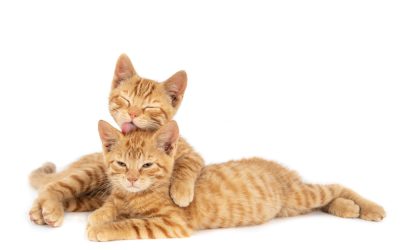What Does Catnip Do To Cats?

If you’ve ever watched your normally dignified cat transform into a euphoric furball after encountering catnip, you’re not alone. This fascinating transformation has captivated cat owners for centuries, and you’ve probably wondered what’s actually happening in your feline friend’s brain during these moments.
The good news? This remarkable behavior is completely normal and safe. Understanding how catnip affects your cat can help you use it more effectively and ensure your furry friend gets the most enjoyment from their favorite herb.
How Catnip Creates Such Dramatic Effects in Your Cat
The secret behind catnip’s power lies in a compound called nepetalactone, which comprises approximately 70-99% of the essential oil in the plant’s leaves and stems. When your cat encounters catnip, this compound binds to special receptors in their nose, creating a cascade of neurological responses that affect multiple areas of their brain.
Think of it as your cat’s sensory processing system being hijacked with delight. The compound mimics specific feline pheromones, particularly those related to mating and territorial behaviors. That’s why you’ll often see your cat exhibiting behaviors during catnip exposure that look a lot like mating rituals – rolling, vocalizing, and rubbing against surfaces.
The intensity of your cat’s reaction depends on several factors, including the amount of nepetalactone present, the duration and frequency of exposure, and their individual genetic sensitivity. Most cats experience the peak effect within 5-15 minutes, followed by a period during which they become temporarily immune to catnip’s influence.
Why Your Cat Might Not Respond to Catnip
Not all cats respond to catnip. About 50-75% of cats inherit the gene that makes them sensitive to nepetalactone, while the remaining 25-50% are completely immune to its effects.
This genetic variation follows a simple pattern – cats either have the sensitivity gene or they don’t. If your cat lacks this gene, they can sniff, lick, or roll in catnip without any noticeable behavioral changes, which can be puzzling (and sometimes disappointing) for their owners.
Age also plays a role in catnip sensitivity. Most cats don’t develop full responsiveness until they reach about 3-6 months of age. Very young kittens may show little interest in catnip, while senior cats sometimes experience reduced sensitivity as their sense of smell declines.
Interestingly, many wild cats – including lions, leopards, and tigers – also respond to catnip, suggesting this sensitivity evolved long before domestic cats came along.
What You’ll See When Your Cat Gets Their Catnip High
When your catnip-sensitive cat encounters the herb, you’ll witness a predictable sequence of behaviors that unfolds over about 10-15 minutes. Understanding these normal responses helps you know what to expect.
The Investigation Phase
Your cat will usually detect the scent from a distance, becoming alert and moving purposefully toward the catnip. You’ll notice dilated pupils and intense focus as they approach. Initial contact involves careful sniffing and tentative licking as they evaluate the strength of the catnip.
Peak Activity and Euphoria
Once the nepetalactone kicks in, you’ll see the classic catnip behaviors: vigorous rolling, rubbing against the catnip source, and various vocalizations from purring to loud meowing. Many cats become unusually affectionate during this phase, while others focus entirely on the catnip itself.
Physical behaviors often include rolling onto their backs, kicking with their hind legs, and what appears to be wrestling with invisible opponents. Some cats drool excessively, while others may have bursts of hyperactive energy followed by intense relaxation.
The Cool-Down Period
After 10-15 minutes of activity, most cats enter a refractory period, during which they become temporarily immune to catnip’s effects. They may appear drowsy or content, or simply return to normal behavior. This period typically lasts 30 minutes to 2 hours.
Is Catnip Safe for Your Cat?
Despite the dramatic behavioral changes catnip produces, it’s remarkably safe for cats. Extensive research and centuries of observation have shown that catnip poses no significant health risks when used appropriately.
No Addiction Concerns
Unlike many mood-altering substances, catnip doesn’t create physical dependence. Your cat won’t develop tolerance or experience withdrawal symptoms when catnip isn’t available. The built-in refractory period actually prevents continuous use and serves as a natural safety mechanism.
Potential Concerns
While catnip itself is safe, some things to keep in mind:
- Choose high-quality, organic catnip products to avoid additives or contaminants
- Excessive consumption of dried catnip can occasionally cause mild digestive upset
- Some cats may become temporarily overstimulated, leading to aggressive behavior
- Pregnant cats should avoid catnip, as large amounts could potentially stimulate uterine contractions
- Very young kittens under 3 months typically don’t respond and don’t need exposure
Different Types of Catnip and Their Effects
- Fresh Catnip: The Premium Experience – Fresh catnip contains the highest concentrations of nepetalactone and typically produces the most intense reactions. If you can grow your own catnip, you’ll provide the freshest possible experience while ensuring quality.
- Dried Catnip: Convenient and Effective – High-quality dried catnip retains significant potency while offering convenience and longer shelf life. It should maintain its green color and strong scent. This is the most practical option for most cat owners.
- Catnip Oil and Concentrates – These highly potent products should be used sparingly. A single drop can provide hours of entertainment, but never apply it directly to your cat. Use these on toys or scratching posts instead.
- Catnip Sprays – Commercial sprays offer controlled dosing and easy application. They’re great for refreshing toys or scratching posts and tend to provide milder effects.
Using Catnip to Enhance Your Cat’s Life
Beyond entertainment, catnip serves many practical purposes in cat care:
Encouraging Exercise
Catnip can motivate sedentary cats to become more active, making it particularly valuable for indoor cats that require additional exercise. Use catnip-infused toys during play sessions to increase enthusiasm and activity duration.
Stress Reduction
Many cats find catnip relaxing, particularly after the initial euphoric period. This makes it useful for helping anxious cats cope with changes, such as moves or the arrival of new family members.
Training and Behavior Modification
Catnip works as a powerful positive reinforcement for training. Use it to encourage scratching post use or redirect destructive behaviors by making appropriate alternatives more appealing.
Catnip Through Your Cat’s Life Stages
- Kittens: Most kittens don’t show catnip sensitivity until 3-6 months of age. Don’t worry if very young kittens show no interest; this is entirely normal.
- Adult Cats: Cats between 1 and 7 years old typically display peak sensitivity, with consistent responses. This is the ideal time for using catnip as an enrichment tool.
- Senior Cats: Older cats may experience a diminished sense of smell due to changes in their olfactory system. They might benefit from stronger concentrations or fresher catnip, but monitor them carefully as some seniors become more sensitive to stimulation.
Troubleshooting Common Catnip Issues
- If Your Cat Becomes Aggressive: Reduce the amount or frequency of catnip use. Some cats are simply more sensitive and need smaller doses for pleasant experiences.
- If Your Cat Stops Responding: Check the quality and freshness of your catnip. Recent stress, illness, or frequent exposure can also affect sensitivity. Try withholding catnip for several weeks to allow sensitivity to return.
- If Your Cat Eats Too Much: Monitor consumption and remove catnip if they attempt to eat large amounts. Select high-quality products with minimal stem material.
Remember, catnip is meant to be a fun, enriching experience for your cat. By understanding how it works and using it appropriately, you can safely enhance your feline friend’s quality of life while enjoying their adorable reactions to their favorite natural high.




